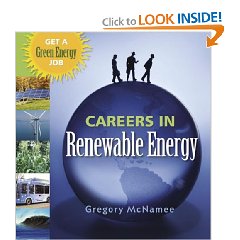
![]() Formula Book Well Executed, Superb But “Lite”
Formula Book Well Executed, Superb But “Lite”
This is a 4 in comparison with many other books, and was disappointingly generic and “lite” in the resource sections, BUT this is BEYOND 6 STARS if you do not have a college education and wither will not get one (see chapters on Solar, Wind, and Geothermal) or are just going into college (see chapters on Bioenergy, Hydro, Buildings, and Energy Management)….so I give it a solid 5 over-all. This book is NOT for “mid-career” folks with degrees looking to switch tracks.
The book consists of seven energy specific chapters, six on “earth-based” renewable energy (solar, wind, geothermal, hydro & marine, bio, hydrogen fuel cells), one on nuclear. The seven appendices are short and ample for a first book but not at all sufficient to make this a reference book of any kind. This is basically a “Dummies Guide to Green Jobs” in *very* general terms.
Having said that, I found myself impressed by the care taken to discuss best colleges and specific college course for those who are college-bound, and to discuss certificate programs for those with a high school education and practical experience.
Another reason I went with a five over-all was because the author uses “Knowledge is Power” as a recurring theme and this I consider hugely beneficial to any reader of this book both in concept and as manifested in this book in each chapter.
Some of my notes:
SOLAR: High school plus certificates (HS+C), move now. Provides 25% of US power now, power to 1 billion people worldwide, k2.3 million full-time jobs now (and growing).
WIND: HS+C. Cheaper than solar by a large factor, lists twelve states where wind farms will be big, top three are North Dakota, Texas, and Kansas.
GEOTHERMAL: HS+C and College/Graduate Engineering. Cheapest and most promising, available everywhere on the planet. Japan, Iceland, New Zealand, Italy, Indonesia, and Canada at the forefront [for those who have not heard, Iceland just declared independence from Denmark, those 600,000 folks are going to be *very* wealthy in the future, especially if they form some kind of Northern Alliance with Eastern Russia, Alaska, and the Yukon and Northwest Territories while keeping their Denmark bridge into Europe).
HYDRO: Provides 90% of the renewable energy in the US now, but the author glosses over the fact that most of our dams are backed up and ready to break. Tidal and wave energy mentioned, but this is an especially “lite” chapter.
HYDROGEN: Twice as efficient as petroleum in producing energy in cars, five types of cells, nine difference processes. This is one way of making renweable energy portable in fuel cells.
Of the four chapters on larger specializations, the ones on Green Building and on Energy Management were best for me, the two on Green Transportation and Teaching Energy very disappointing.
BUILDINGS. I learn buildings in the USA use 39% of our energy, 12% of our water, and that Green Buildings are a 12 billion dollar a year industry and growing.
ENERGY MANAGEMENT. For a mid-career person this is the one chapter that makes the book worthwhile, the author makes the point that this field is very computationally intense and most demanding in terms of advanced education.
The appendices are very lite after the first one (Where to Study: 50 Schools), but cover web sites, online job listings, workshops, associations, and state energy offices. Then a gloassary worth reading, and an index.
Bottom line: a superb and very reasonably priced overview book for anyone who either wants to think about college as a path into the green jobs of the future, or for anyone who wants to forego college and think about business options that are just now starting to boom. In both cases I also recommend the two books above, and the following (in the case of the below, reading my summary reviews may suffice):
Biomimicry: Innovation Inspired by Nature
Cradle to Cradle: Remaking the Way We Make Things
The Design of Business: Why Design Thinking is the Next Competitive Advantage
Ecological Economics: Principles And Applications
Green to Gold: How Smart Companies Use Environmental Strategy to Innovate, Create Value, and Build Competitive Advantage
Natural Capitalism: Creating the Next Industrial Revolution
The Resilient Earth: Science, Global Warming and the Fate of Humanity



